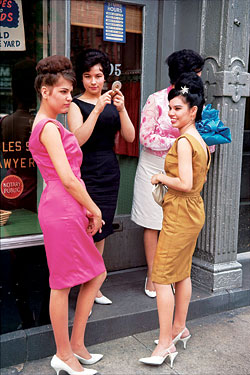
Semi-officially, the Cold War had ended the previous fall, when the Cuban Missile Crisis came and just as quickly went. After a decade of warnings, nuclear Armageddon was not going to happen after all.
And so the fifties were over, but “the sixties” hadn’t begun. New York was feeling the revved-up heat of something just beginning, spiked by the thrill of watching the past recede in the rearview mirror. A vapor trail of postwar optimism lingered. The Dodgers had left us, but the Mets had arrived, and even if they were a joke, you knew they’d step up. The city was changing, growing up, getting sleeker and cooler but, like a child with a blanket scrap, clutching onto its grubby past.
A feeling that something new was happening burbled up from the gap between the Beats and the hippies. Bob Dylan played Town Hall, John Coltrane and Johnny Hartman recorded their studio album, Frank O’Hara had just written his great “Lana Turner Has Collapsed!” poem. Suzanne Farrell was dancing with George Balanchine’s New York City Ballet. Andy Warhol was painting Marilyn Monroe, Jasper Johns showing at Castelli, Candy Darling and Holly Woodlawn finding their way to town. At the Art, the Paris, the Thalia, you could watch Resnais or Truffaut, or Jack Smith and Kenneth Anger at the Film-Makers’ Cooperative. Grace Paley and Donald Barthelme were writing buddies in the West Village. The newspaper strike had given birth to The New York Review of Books. Even an inconvenience led to something good.
No one had told New York it would have to pay for its comfort by sacrificing so much of its sleazy sparkle. Under the puffing Camels sign, Times Square thrummed with porn, but middle-class kids hung out there too, and it was okay with their parents. Then as now, no one worried about coming home late on the subway, but there were decades in between when everyone did. Uptown and down, commerce had a pre-corporate, mom-and-pop appeal. A Madison Avenue gallery sold Picasso ceramics for not all that much money, while in Greenwich Village, bearded guys made sandals and guitars in the backs of dusty storefronts. There were no independent bookstores, just bookstores, and plenty of them: the Eighth Street Book Store, Brentano’s, Scribner’s. You could spend all day on Fourth Avenue, browsing the secondhand shops crammed with the catalogues, postcards, and prints that Joseph Cornell mined for his shadow boxes. Soho, still barely a place to live, was a cast-iron no-man’s-land between Chinatown and the Village.
JFK was in the White House, which was a nice feeling too. Or anyway, that’s what we thought. By November he would be dead. After that came a lot of things: municipal bankruptcy, crippling strikes, crack, aids, 9/11. How surprising that the city should have been balanced on a cusp. And how gorgeous the view was from that precarious height. New York was beautiful in a way that a city can be only when no one’s thinking how quickly the moment will pass.